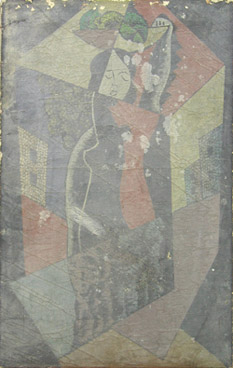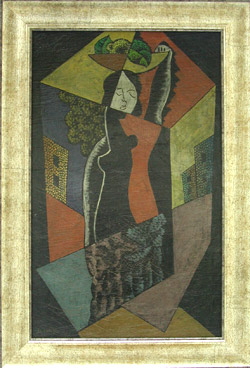|
|
What does the Mona Lisa have in common with great-grandmamma?If you have been lucky enough to obtain an original Mona Lisa or you have a precious antique photograph of your beloved great-grandma, you will certainly not want this emotionally or financially valuable article to lose its value because of a lack of correct treatment.
I have two messages (as conventional one is good and one is bad): the bad message is that all our works of art undergo a process of deterioration, even marble statues, and especially oil paintings, and works on paper. Each art work has its own rate of deterioration.
  1. Oil on canvas, damaged by injurious treatment, dust, fading of color and stains 2. The painting after cleaning, stabilization, repair and protective coating
If this were not sufficient, all art works also have to deal with other injurious factors such as mold, different insects such as the ‘silverfish’, wood beetles, or as they are known by us, different types of woodworm, and even rodents. To this is added air pollution – a relatively new hazard, which the generations before the Industrial Revolution did not have to face; the dust, soot and sulfur compounds in the air cause changes in colors, stains, fading and weakening of the foundation of the creative work. Most of us think that if we have taken the trouble to frame our pieces of art, they will be protected. However, to my regret and probably to yours too, the opposite is true. Most of the framing conducted in Israel not only fails to protect the artwork but also harms it in a very harsh manner.
The use of acidic framing materials and intrusive glues often causes irreversible damage.
Till this point, everything sounds terrible and threatening, so what does this mean: is every one of our artworks doomed to destruction? Not necessarily. With some awareness of these enemies and care for several ‘rules-of-thumb’ we can provide our treasured art works with a reasonable term of life.
In relation to relative humidity and temperature, it is now possible to easily create climate control in an apartment or specific room where precious items are displayed. Correct framing , known as conservational/ OR conservative framing, that is adapted to the specific needs of each artwork, significantly improves its durability to the influences of climate, air pollution, radiation, and injuries caused by the most dangerous agent – man. Intelligent use of blinds, curtains, UV-free lighting and special screens installed on windows or on the artwork itself can drastically reduce the aggressive influence of light.
Artworks which were usually displayed without glazing such as oil paintings must be protected with protective coating (varnish) adapted specifically to the art media. A painting that remains without proper coating is at risk to the same extent as a gouache or aquarelle painting without glass.
Every painting needs special backing, which provides physical protection, preventing the intrusion of dust, insects and humidity and yet also allowing the artwork to ‘breathe’. It is only in places such as museums, which are protected by complete climate control that works on canvas can be displayed without backing. Long experience indicates that correct treatment of an artwork, document or other precious item, is also financially worthwhile, since conservation is far less expensive than restoration or repair of injuries caused by negligence or incorrect treatment.
If you are amazed that almost no one talks about, instructs or warns you about these important issues, I agree with you entirely. To my regret there are very few academic institutes that have undertaken to train artists, curators and museum caretakers in this fundamental field of knowledge, conserving works of art.
I therefore devote not a little time and effort to transmit this important knowledge to the public with lectures and workshops, in private and institutional settings and also by distributing informational leaflets that describe the proper treatment of artworks. Recently I have also established a detailed website, largely devoted to explanations concerning the correct treatment of works of art and providing professional links for those who wish to discover deeper knowledge.
© All rights reserved to Michael Karov Karo, Karo Arts
Back to articles |
|
Karo-Arts.com © 2008 | דף הבית - קארו אמנויות
|

